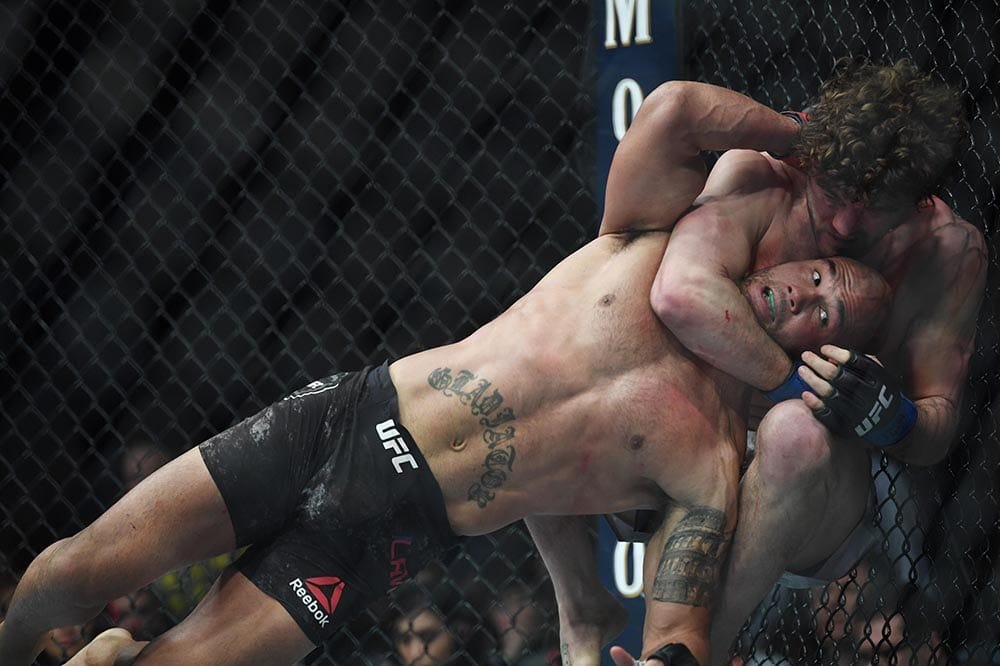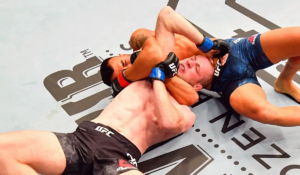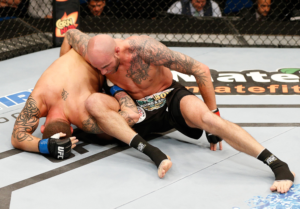If you’re a fan of mixed martial arts (MMA) or Brazilian Jiu-Jitsu (BJJ), you’ve probably heard of the bulldog choke. This submission is a type of chokehold that’s used to force an opponent to submit by cutting off their air supply. Although the bulldog choke isn’t as common as other submissions like the rear-naked choke or armbar, it’s still a highly effective technique that can be used to quickly end a fight.
The bulldog choke is a versatile submission that can be used in a variety of situations. It can be executed from a standing or ground position and can be used to finish a fight or simply gain a dominant position. In MMA, the bulldog choke has been used to great effect by fighters like Ben Askren and Carlos Newton. It’s also a popular technique in BJJ, where it’s often used as a surprise submission to catch opponents off guard.
Understanding the Bulldog Choke
If you are looking for a complete and effective submission technique in Brazilian Jiu-Jitsu or grappling, the Bulldog Choke is an excellent option. It is a headlock submission that can be executed in various ways, and it provides excellent control over your opponent. In this section, we will explain the basic technique of the Bulldog Choke and its variations.
Basic Technique
The Bulldog Choke is a technique that involves using your arms to apply pressure to your opponent’s neck. To execute this technique, you need to follow these steps:
- Get behind your opponent and wrap your arms around their neck.
- Place your hands together and lock your fingers.
- Squeeze your arms together to apply pressure to your opponent’s neck.
- Use your body weight to control your opponent and prevent them from escaping.
The Bulldog Choke is a simple technique that can be executed from various positions, including the mount, side control, and back control. It is a quick and unexpected submission that can catch your opponent off guard.
Variations
There are several variations of the Bulldog Choke that you can use to surprise your opponent. Here are some of the most common variations:
- Arm-In Bulldog Choke: This variation involves trapping your opponent’s arm inside the choke. It provides additional control and makes it harder for your opponent to escape.
- No-Gi Bulldog Choke: This variation is executed without the use of a gi. It requires a different grip and more reliance on body weight to apply pressure.
- Catch Wrestling Bulldog Choke: This variation is commonly used in catch wrestling. It involves using a modified grip and applying pressure to both sides of your opponent’s neck.
In conclusion, the Bulldog Choke is an effective and unexpected submission technique that can be used in Brazilian Jiu-Jitsu, grappling, and catch wrestling. It is a headlock submission that provides excellent control over your opponent and can be executed from various positions. With the right technique and practice, you can become proficient in executing the Bulldog Choke and add it to your arsenal of submission techniques.
Historical Use of Bulldog Choke
The Bulldog Choke is a submission technique that has been used in various forms of combat sports for many years. It is a simple yet effective chokehold that can be executed from a variety of positions. Here we will take a look at the historical use of the Bulldog Choke in UFC and MMA.
In UFC

One of the most notable uses of the Bulldog Choke in UFC was during UFC 235 in 2019. Ben Askren, a former Olympic wrestler, caught Robbie Lawler in the chokehold and won the fight. This match gained a lot of attention because Lawler’s arm went limp, and there was some controversy over whether or not the choke was applied correctly.
In MMA
The Bulldog Choke has been used in MMA for many years, with some fighters becoming known for their proficiency in executing the technique. One of these fighters is Pat Miletich, a former UFC welterweight champion. Miletich was known for his ability to apply the Bulldog Choke from a variety of positions and angles.
The Bulldog Choke is a versatile technique that can be used from a number of positions, including side control, mount, and back control. It is particularly effective when applied from side control, as the attacker can use their body weight to apply pressure to the opponent’s neck.
Overall, the Bulldog Choke is a simple yet effective technique that has been used in combat sports for many years. It is a versatile technique that can be executed from a variety of positions and angles. Whether you are a beginner or a seasoned fighter, the Bulldog Choke is a technique that you should have in your arsenal.
Defending Against Bulldog Choke
If you find yourself in a situation where your opponent is attempting a bulldog choke, don’t panic. There are several ways to defend against it and escape the submission.
Basic Defense
The first step in defending against the bulldog choke is to maintain good posture. Keep your chin tucked and your neck straight to prevent your opponent from getting a good grip on your head. If your opponent manages to get their arm around your neck, use your hands to defend against the choke. Place one hand on your opponent’s bicep and the other hand on their wrist to prevent them from tightening the choke.
If your opponent has already secured the choke, you can try to escape by turning into them. This will help relieve the pressure on your neck and give you a chance to escape the submission. You can also try to create space by pushing your opponent’s hips away from you with your legs.
Advanced Techniques
If the basic defense is not working, you can try some advanced techniques to escape the bulldog choke. One technique is to use your opponent’s momentum against them. As they apply the choke, quickly drop your weight and roll backwards. This will cause your opponent to lose their balance and give you an opportunity to escape.
Another technique is to use a counter choke. As your opponent applies the bulldog choke, use your free hand to grab their collar and pull it towards you. This will create pressure on your opponent’s neck and force them to release the choke.
Remember, the key to defending against the bulldog choke is to stay calm and maintain good posture. With practice and experience, you can become proficient in defending against this submission and escape it with ease.
Famous Bulldog Choke Matches
If you are a fan of mixed martial arts, you have probably seen the bulldog choke in action. This rare catch wrestling submission has been used in some of the most memorable fights in MMA history. In this section, we will take a closer look at two famous bulldog choke matches.
Ben Askren vs Robbie Lawler
One of the most controversial bulldog choke matches in recent memory was the fight between Ben Askren and Robbie Lawler at UFC 235. Askren, a former Bellator and ONE Championship welterweight champion, was making his UFC debut and was looking to establish himself as a top contender in the division.
The fight started with Lawler aggressively attacking Askren with strikes and takedowns. However, Askren was able to weather the storm and eventually got Lawler’s back. From there, he locked in a bulldog choke and appeared to put Lawler to sleep.
However, the referee deemed that Lawler was still conscious and stopped the fight, much to the dismay of Lawler and many fans. The controversy surrounding the stoppage overshadowed what was an impressive debut for Askren.
Raquel Pennington vs Uriah Faber
Another famous bulldog choke match took place between Raquel Pennington and Uriah Faber in a WEC event in 2008. Pennington, who was making her professional debut, was facing off against Faber, a veteran of the sport and former WEC featherweight champion.
The fight was a back-and-forth affair, with both fighters having their moments. However, in the second round, Pennington was able to take Faber’s back and lock in a bulldog choke. Faber tried to fight out of it, but eventually had to tap, giving Pennington the upset victory.
The win was a huge moment for Pennington, who went on to have a successful career in MMA. For Faber, it was a setback, but he would go on to have a legendary career and become one of the most beloved fighters in the sport.
Both of these matches demonstrate the effectiveness and potential controversy of the bulldog choke as a submission technique in MMA. While it may not be as well-known as the rear naked choke or other submissions, the bulldog choke has proven to be a powerful weapon in the right hands.
Bulldog Choke in Different Positions
The bulldog choke is a highly effective submission that can be executed from various positions. In this section, we will explore two of the most common positions from which you can execute the bulldog choke: turtle position and back control.
From Turtle Position
The turtle position is a defensive position commonly used in Brazilian Jiu-Jitsu. It is a position where the opponent is on their hands and knees, with their back facing upwards. To execute the bulldog choke from turtle position, follow these steps:
- Start by getting behind your opponent and securing the turtle position.
- Next, use your arms to control your opponent’s shoulders and prevent them from escaping.
- Reach under your opponent’s chin with one arm and grab their opposite shoulder with your other arm.
- Pull your opponent’s shoulder towards you while pushing their head away with your other arm.
- Squeeze your arms together to apply pressure to your opponent’s neck and force them to submit.
From Back Control
Back control is a dominant position where you are behind your opponent and have hooks in to control their hips. To execute the bulldog choke from back control, follow these steps:
- Start by securing back control and placing your hooks in.
- Use your arms to control your opponent’s shoulders and prevent them from escaping.
- Reach under your opponent’s chin with one arm and grab their opposite shoulder with your other arm.
- Pull your opponent’s shoulder towards you while pushing their head away with your other arm.
- Squeeze your arms together to apply pressure to your opponent’s neck and force them to submit.
In both positions, it is important to control your opponent’s shoulders and prevent them from escaping. It is also crucial to use your hips to create leverage and apply pressure to your opponent’s neck. With practice and proper technique, the bulldog choke can be a highly effective submission from various positions.
Bulldog Choke in Different Styles
The bulldog choke is a powerful submission that can be executed in different styles. In this section, we will discuss the bulldog choke in no-gi and Brazilian Jiu-Jitsu.
In No-Gi
In no-gi, the bulldog choke is a popular submission that can be executed from various positions. It is a choke that can be applied quickly and efficiently, making it a favorite among wrestlers and MMA fighters.
To execute the bulldog choke in no-gi, you need to have a good grip on your opponent’s neck. The most common grip used is the gable grip, where you interlock your hands behind your opponent’s head. Another grip that can be used is the S-grip, where you place one hand on top of the other and grab your opponent’s neck.
Once you have a good grip, you need to move into position and apply pressure to your opponent’s neck. The bulldog choke can be executed from the side control, north-south, and turtle positions.
In Brazilian Jiu-Jitsu
In Brazilian Jiu-Jitsu, the bulldog choke is a sneaky submission that can catch your opponent off guard. It is a submission that is not commonly used in competitions, but it is effective when executed correctly.
To execute the bulldog choke in Brazilian Jiu-Jitsu, you need to have good control over your opponent’s upper body. The most common setup for the bulldog choke is from the back mount position, where you have your hooks in and your opponent is turtled up.
From this position, you can slide your arm under your opponent’s neck and grab your own bicep. This grip is known as the Rena grip. You can also use the kimura grip to execute the bulldog choke.
Once you have a good grip, you need to apply pressure to your opponent’s neck and squeeze your arms together. The bulldog choke can be a difficult submission to defend, and it can put your opponent to sleep quickly if executed correctly.
In conclusion, the bulldog choke is a versatile submission that can be executed in different styles. Whether you are a fan of wrestling, MMA, or Brazilian Jiu-Jitsu, the bulldog choke is a submission that you should add to your arsenal. With practice and patience, you can become proficient in executing this powerful submission.
Execution of Bulldog Choke
The Bulldog Choke is a highly effective submission hold used in Brazilian Jiu-Jitsu (BJJ) and Mixed Martial Arts (MMA). It is a chokehold that targets the opponent’s neck and windpipe, causing them to submit or pass out. The Bulldog Choke can be executed from a variety of positions, including the guard, side control, and mount.
To execute the Bulldog Choke, you first need to establish a dominant position over your opponent. This can be done by using a sprawl or by passing their guard. Once you have secured a dominant position, you can then begin to work towards applying the choke.
One common way to set up the Bulldog Choke is to first threaten a guillotine choke. As your opponent defends against the guillotine, you can transition to the Bulldog Choke. To do this, you need to reach under your opponent’s arm with your opposite hand and grab their collar. You then need to slide your other arm under their neck and grab your own collar. From here, you can apply pressure and choke your opponent.
Another way to set up the Bulldog Choke is to use the clock choke as a setup. The clock choke involves wrapping your arm around your opponent’s neck and grabbing their collar. As your opponent defends against the clock choke, you can transition to the Bulldog Choke by sliding your arm under their neck and grabbing your own collar.
When executing the Bulldog Choke, it is important to maintain control over your opponent and to apply steady pressure. You should also be aware of your opponent’s movements and be prepared to adjust your position if necessary.
Overall, the Bulldog Choke is a highly effective submission hold that can be used to quickly and efficiently end a fight. With proper execution and control, you can use this technique to gain the upper hand over your opponent and secure a victory.
Impact of Bulldog Choke
The Bulldog Choke is a highly effective technique that can have a significant impact on a fight. When executed correctly, it can quickly put your opponent to sleep, causing them to lose consciousness and the fight.
One of the major advantages of the Bulldog Choke is that it can be applied from a variety of positions, making it a versatile technique that can be used in a variety of situations. Whether you are in top position or on the bottom, the Bulldog Choke can be used to gain an advantage over your opponent.
In addition to its effectiveness as a submission technique, the Bulldog Choke can also be used to create pain and discomfort for your opponent. This can be particularly useful in situations where you are trying to gain an advantage in a scramble or during a competition.
Martial artists who are skilled in the Bulldog Choke can use it to great effect in both training and competition. By mastering this technique, they can gain a significant advantage over their opponents and increase their chances of victory.
However, it is important to remember that the Bulldog Choke can be a dangerous technique if not executed properly. Applying too much pressure or holding the choke for too long can cause serious injury or even death. It is important to always use caution when applying this technique and to seek proper training and guidance from a qualified instructor.
In summary, the Bulldog Choke is a highly effective technique that can have a significant impact on a fight. It can be used to put your opponent to sleep, create pain and discomfort, and gain an advantage in a variety of situations. However, it is important to use caution and seek proper training to ensure that it is executed safely and effectively.
Frequently Asked Questions
What is the difference between a bulldog choke and a reverse bulldog choke?
The bulldog choke and the reverse bulldog choke are similar techniques, but they differ in the direction of the choke. In the bulldog choke, you wrap your arm around your opponent’s neck from the side, while in the reverse bulldog choke, you wrap your arm around your opponent’s neck from the front. The reverse bulldog choke is also known as the “front headlock choke.”
How do you execute an anaconda choke?
To execute an anaconda choke, you start by wrapping your arm around your opponent’s neck, and then you use your other arm to grab your own bicep. From there, you roll onto your back and use your legs to trap your opponent’s body. You then squeeze your arms together to apply pressure to your opponent’s neck.
What is the difference between a bulldog choke and a Darce choke?
The bulldog choke and the Darce choke are similar techniques, but they differ in the position of the arms. In the bulldog choke, your choking arm is wrapped around your opponent’s neck from the side, while in the Darce choke, your choking arm is wrapped around your opponent’s neck from the front. The Darce choke is also known as the “brabo choke.”
Can a bully choke be used in self-defense situations?
The bulldog choke, like any choke, can be a dangerous technique if not executed properly. However, it can be an effective self-defense technique if used in the right situation. It is important to remember that using excessive force in self-defense can result in legal consequences.
What is the proper technique for executing a guillotine choke?
To execute a guillotine choke, you start by wrapping your arm around your opponent’s neck and grabbing your own wrist. From there, you use your other arm to pull your opponent’s head down towards your chest while squeezing your arms together to apply pressure to your opponent’s neck.
How effective is the executioner choke in competition?
The executioner choke, also known as the “Von Flue choke,” can be an effective technique in competition if executed properly. However, it is a less common technique and may not be as effective against experienced opponents who are familiar with the technique.



